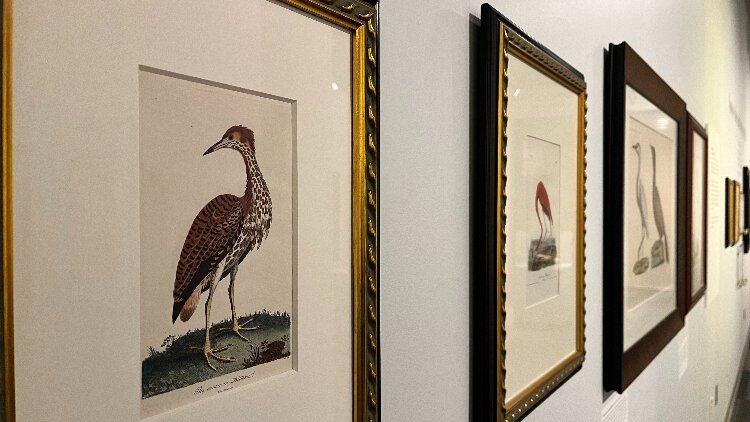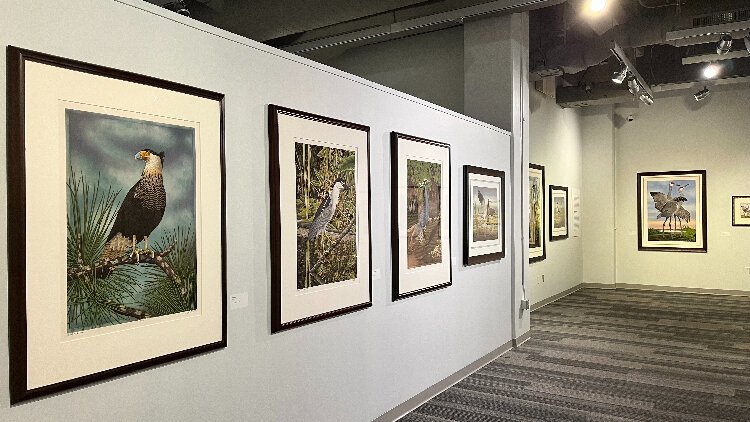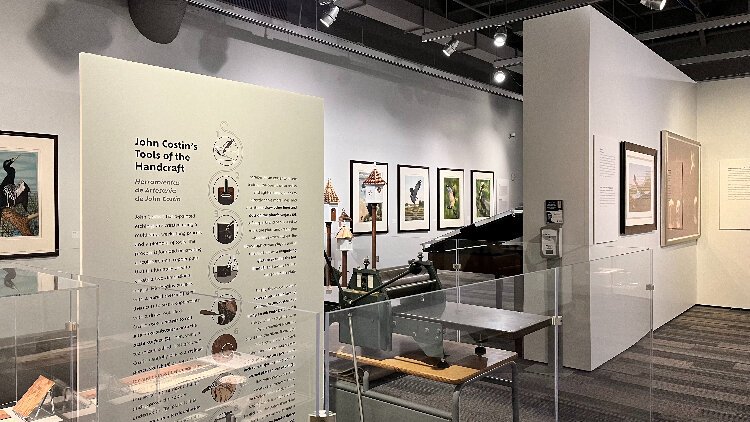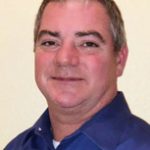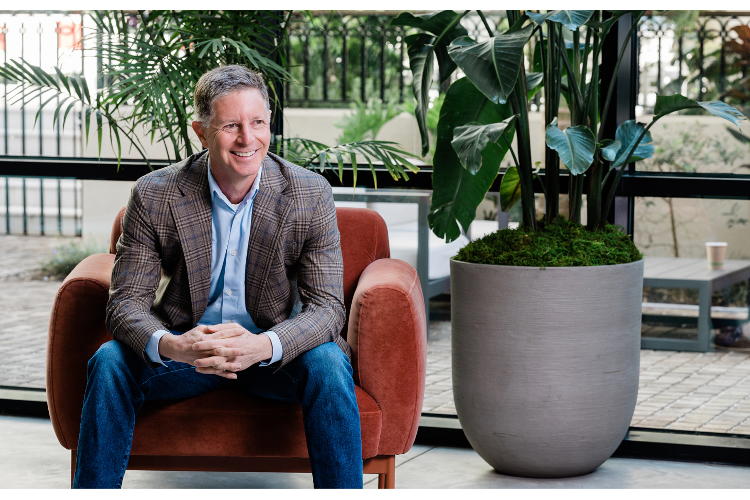Etched Feathers: A journey through the history of bird art
The Tampa Bay History Center's "Etched Feathers" exhibit showcases Tampa artist John Costin's artwork and art collection in a journey through the history of bird art and printmaking.
Over the years, Tampa artist John Costin has built a reputation for his life-size portraits of Flordia’s iconic birds: a roseate spoonbill in flight, a great blue heron standing along the shore, a snowy egret spreading its wings.
The new “Etched Feathers” exhibition at the Tampa Bay History Museum showcases Costin’s artwork and his collection of antique prints in an experience that is an art exhibit, an art history lesson and an homage to the birds that have fascinated visitors to Florida for hundreds of years. Some of Costin’s artwork was previously part of an exhibit on conservation the History Center put on in collaboration with Audubon Florida in 2018 and 2019. That laid the groundwork for “Etched Feathers,” which opened March 4th and runs to October 15th.
“Costin’s an artist but he’s also a collector,” Tampa Bay History Center curator Brad Massey says while walking through the exhibit. “So when we collaborated on this we said, ‘Sure we want to feature your work, but your collection’s really cool too.’ It stretches back several centuries. So he loaned us a lot of these works.”
Antique pieces in the exhibit date back to a 1669 print of a heron. While most of the historic artwork on display is from Costin’s own collection, pieces like the book “The Natural History of Carolina, Florida and the Bahama Islands” by 18th Century English-born naturalist and artist Mark Catesby are on loan from the University of South Florida Libraries Special Collections.
“He is one of the first ornithologists,” Costin, who studied art history and printmaking in college, says of Catesby. “There were a couple of people before him but no one had done it to that extent. It’s an incredible book.”
Costin says for naturalists and artists of Catesby’s time, Florida was like nothing they had ever seen before.
“They’re coming from Europe and they’ve never seen these plants and animals and birds before,” he says. “This is brand new to them. This is a new frontier. Florida at that time is a swamp land. There were a few cities here but very remote. It was a different world.”
Beyond natural history, Massey says the antique prints in the exhibition will show how printing processes have evolved over the last 500 years from woodcut to etching, engraving and, eventually, lithography.
Costin is a printmaker who does handmade etchings on copper plates. It is one of the oldest forms of printing but has evolved into an art form involving meticulous attention to detail. A segment from Southwest Florida’s WGCU-PBS program Arts Edition Primetime details his process.
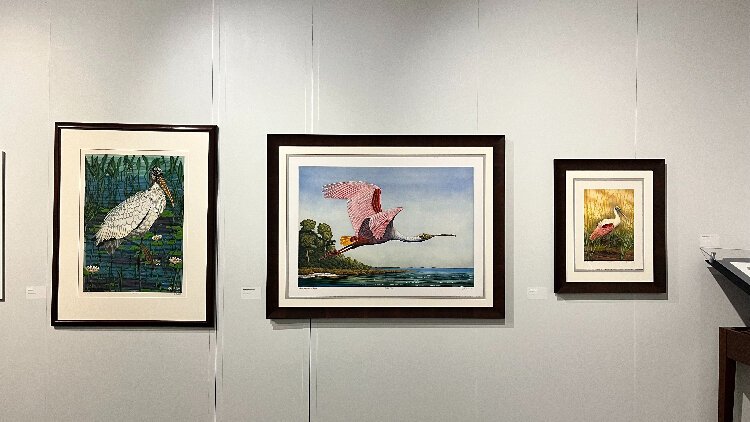
Costin begins with a sketch and a watercolor. To transfer the work to a copper plate, he coats the plate in a soft, sticky ground. After the ground dries, he places his sketch face down over the plate and transfers it by sketching over it. He also draws directly on copper plates to create texture. When he is finished with the etching, the plate goes in an acid bath. After that, he spreads ink on the plate and pushes ink into the etching grooves. He then runs the plate through a press to transfer the image onto a print. Costin uses multiple plates and goes through the printing process multiple times to layer the print with color. He then meticulously hand-colors the print. Costin says he plans to delve into his process during an April 12th talk on his work and the exhibit that he is giving as part of the Tampa Bay History Center’s Duckwall Lecture series.
On top of the unique, time-consuming and intricate process involved in creating a print, Costin’s artwork requires extensive ornithological knowledge. He says his fascination with birds dates back to a young age.
“They’re from another era,” he says. “They’re like contemporary dinosaurs.”
The fact that the birds survived the mass extinction event that wiped out the dinosaurs only adds to his fascination.
“They survived through a couple of times when this planet took a real beating,” Costin says. “One of the reasons they survived is because they could fly and move. I find them fascinating – their form, their colors, their life histories, how they survive, how they mix with other species of birds, their migration. As I began reading and learning about them, the more l learned and the more fascinated I became with them. It sort of snowballed, this passion about birds.”
Living in the Tampa Bay area, Costin has a treasure trove of bird-watching spots to inspire and inform his art. One spot on Tampa Bay is a short drive from his studio. Fort De Soto Park is another favorite destination. In the field, Costin will take hundreds of pictures of birds. Back at his studio, he organizes and files pictures by species. The photos are not the creative influence for his portraits. Instead, Costin references them for accuracy of details like the size and scale of the legs and feet, feather patterns, color and the scaling on the legs.
Massey says Costin’s vivid, detailed prints and our fascination with birds have combined to make “Etched Feathers” a popular exhibit.
“There has been a lot of interest in this show,” he says. “It really taps into two crowds- the birding crowd and an art crowd.”
John Costin’s talk as part of the annual Duckwall Lecture series is scheduled from 6:30 p.m. to 8 p.m. on Wednesday, April 12th at the Tampa Bay History Center’s TECO Hall. The event is free and open to the public.
For more information, go to Etched Feathers and Annual Duckwall Lecture.

